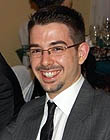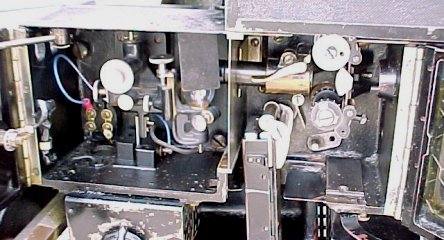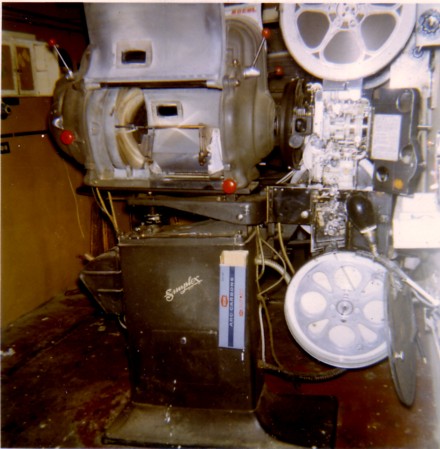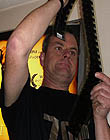|
|
This topic comprises 2 pages: 1 2
|
|
Author
|
Topic: Gate Type Soundheads
|
|
|
|
|
|
|
|
|
|
|
|
|
|
|
|
|
Monte L Fullmer
Film God

Posts: 8367
From: Nampa, Idaho, USA
Registered: Nov 2004
|
 posted 05-22-2005 08:54 PM
posted 05-22-2005 08:54 PM




..It was the Royal Theatre in Rigby, Idaho. This was my first indoor house that I worked at..in the fall of 1971 until Clayton put in those 5 star units and the ORCS.
When I went up to this booth, after meeting with the owner who needed help bad, I saw this E-7/Strong Mogul setup and saw these 'ancient' soundheads. Having that 40lb dual cord belt driven flywheel on the backside (where you can barely see the flywheel in the pict), I was a bit amazed of this style, since that fall, when the drive-in shut down and used to Ballantyne Model 6 sound heads (which were about the same as the 4-star and the RCA's), then seeing a gate version of a sound head that uses the pulldown sprocket as the scanner drum. I had to reverse this sprocket on this right machine since the sprocket was hooking badly.
One time, Clayton came up to do a sound check and a oblique gear replacement, (which eventually I found out how horrible they can be to work on down the road, and which this place actually had Motiograph stereo magnetic sound-for there were the three Altec/Lansings "Voice of the Theatre" speakers behind screen, booth had 4 Motiograph amplifiers, I found the two Motiograph Penthouses in storage) and he was impressed on how these things sounded being the gate-type sound system (he also mentioned that the old Rialto in downtown SLC, which is still there on the 200 block of Main street with a different name, had these 206's also) and how there was very little flutter coming from these old heads.
Here's the pict after Clayton did the 5-star install (sorry on the fuzzy shoots-couldn't hold a instamatic worth beans..lol):
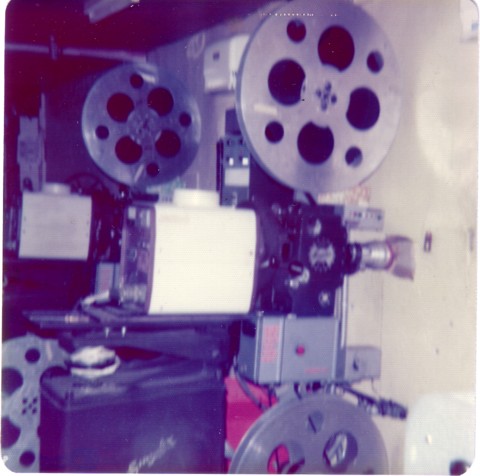
After I left this theatre, business started to plummet due to sloppy operations, health conditions and overall poor situations there. Finally, the theatre went up in a blazing fire. Some said that the coal furnace in the basement let go, and the auditorium, with wood floors soaked with syrup and popcorn grease added to the destruction, but others figured out that it was ARSON to get the insurance money due to lack of business and massive debt that had piled up.
I went there after the fire and saw a huge glob of aluminum-figured this what was left of the machinery. Nothing was readilly recoginizable. That fire definitely consumed almost everything-nothing but the ajoining walls were left.
Lotsa fun I had in my early years handling film. That was a very dirty booth when I first started. I must have spent a good 3 months cleaning it up to where it was quite liveable up there.
thx-Monte
| IP: Logged
|
|
|
|
|
|
|
|
|
|
|
|
|
|
|
|
All times are Central (GMT -6:00)
|
This topic comprises 2 pages: 1 2
|
Powered by Infopop Corporation
UBB.classicTM
6.3.1.2
The Film-Tech Forums are designed for various members related to the cinema industry to express their opinions, viewpoints and testimonials on various products, services and events based upon speculation, personal knowledge and factual information through use, therefore all views represented here allow no liability upon the publishers of this web site and the owners of said views assume no liability for any ill will resulting from these postings. The posts made here are for educational as well as entertainment purposes and as such anyone viewing this portion of the website must accept these views as statements of the author of that opinion
and agrees to release the authors from any and all liability.
|

 Home
Home
 Products
Products
 Store
Store
 Forum
Forum
 Warehouse
Warehouse
 Contact Us
Contact Us




 Printer-friendly view of this topic
Printer-friendly view of this topic
